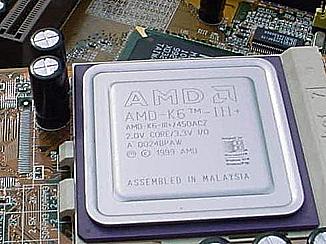AMD K6-III
|
|
The K6-III was an x86 microprocessor manufactured by AMD, the last and fastest of all Socket 7 processors. It achieved the distinction of being the fastest X86 processor on the market on release, and remained highly competitive for a considerable time afterwards.
In conception, the design was simple: it was a K6-2 with an additional level of cache on-Die (Level 2). The original K6-2 had a 64 KiB primary cache and a much larger amount of motherboard-mounted cache (usually 512 KiB or 1 MiB but varying depending on the choice of main board). In contrast the competing Intel parts used 32 KiB of primary cache and either 128 KiB of full-speed secondary cache integrated into the CPU itself (Celeron) or 512 KiB of half-speed cache mounted on a processor daughter board (Pentium II, Pentium III). The K6-III, however, used both methods: it had 64 KiB primary cache, a massive 256 KiB on-chip, full-speed secondary cache (similar to the Celeron's but twice the size), and the variable size motherboard mounted cache on the Socket 7 main board became a tertiary level.
In execution, however, the design was not simple: with 21.4 million transistors, it was a very large chip to manufacture with early 1999 technology, and the K6 core design did not scale well past 500 MHz. Nevertheless, the K6-III 400 sold well, and the K6-III 450 was clearly the fastest X86 chip on the market on introduction, comfortably outperforming AMD's K6-2s and Intel's Pentium IIs.
Intel's Pentium-II replacement was not yet available but, as a stop-gap, Intel introduced a modestly revised version of the P-II and re-badged it as the "Pentium III". The base design was unchanged (the addition of SSE instructions was at that time of no performance significance) but Intel's new production process allowed clockspeed improvements, and it became difficult to determine which company's part was the faster. Most industry observers regarded the Intel part as superior for floating-point intensive tasks, but the K6-III as better for mainstream integer work.
Both firms were keen to establish a clear lead, and both experienced manufacturing problems with their higher-frequency parts. AMD chose not to release a 500 MHz or faster K6-III, preferring to concentrate on their soon-to-be-released Athlon instead. Intel produced a 550 MHz Pentium-III with some success but their 600 MHz version had reliability issues and was soon recalled and customers given a refund.
With the release of the Athlon, the K6-III became something of an orphan. No longer a top-of-the-line part, it nevertheless required substantial manufacturing resources to produce: at 21.4 million transistors, it was almost as expensive to make a K6-III as a 22-million-transistor Athlon, and the same area of silicon could make more than two of the 9.3 million-transistor K6-2 parts. For a time, the K6-III was a low priority part for AMD—something to be made only when all orders for high-priced Athlons and cheap-to-produce K6-2s had been filled—and it became difficult to source in quantity.
The original K6-III went out of production when Intel released their "Coppermine" Pentium III (a much improved part that used internal, on-die cache like a Celeron or a K6-III) and, at the same time, switched to a new production process. The changeover was fraught with difficulties and Intel CPUs were in global short supply for 12 months or more. This, coupled with the outstanding performance of the Athlon, resulted in even many former Intel-only manufacturers ordering Athlon parts, and stretched AMD's manufacturing facilities to the limit. In consequence, AMD stopped making the K6-III in order to leave more room to manufacture Athlons (and K6-2s).
By the time the global CPU shortage was over, AMD had developed revised versions of the K6 family: the K6-2+ and the K6-III+. Essentially, both parts were K6-IIIs (the 2+ with a 128 KiB cache, the III+ with the full 256 KiB) made on a new production process. Although targeted at notebook computers, both parts were also available for desktop systems. AMD continued to devote their marketing resources to the Athlon and neither part became well-known outside the industry, but both had modest success and became firm favourites with the overclocking community. K6-III/450+ parts routinely overclocked to almost 600MHz before hitting motherboard frontside bus limits (indicating considerable room for further clockspeed ramping) and had it not been for the outstanding success of the Athlon and the gradual disappearance of suitable Socket 7 mainboards from the market, the K6 family may well have stayed in production longer. Many K6-IIIs remain in service today.
Models
K6-III "Sharptooth" (K6-3D+, 250 nm)
- L1-Cache: 32 + 32 KB (Data + Instructions)
- L2-Cache: 256 KB, fullspeed
- MMX, Extended 3DNow!
- Super Socket 7
- Front side bus: 100 MHz
- VCore: 2.2 V, 2.4 V
- First release: February 22, 1999
- Fertigungstechnik: 0,25 Ám
- Taktraten: 400, 450 MHz
K6-III+ (180 nm)
- L1-Cache: 32 + 32 KB (Data + Instructions)
- L2-Cache: 256 KB, fullspeed
- MMX, Extended 3DNow!
- Super Socket 7
- Front side bus: 100 MHz
- VCore: 2.0 V
- First release: April 18, 2000
- Clockrate: 450, 475, 500 MHz
K6-2+ (180 nm)
- L1-Cache: 32 + 32 KB (Data + Instructions)
- L2-Cache: 128 KB, fullspeed
- MMX, Extended 3DNow!
- Super Socket 7
- Front side bus: 100 MHz
- VCore: 2.0 V
- First release: April 18, 2000
- Clockrate: 450, 475, 500, 533, 550 MHz
External links
- AMD: AMD-K6«-III Processor (http://www.amd.com/us-en/Processors/ProductInformation/0,,30_118_1260_1288,00.html)
- CPU Upgrade: Getting the AMD K6-2+ / K6-III+ to work on your Super Socket 7 board (http://web.inter.nl.net/hcc/J.Steunebrink/k6plus.htm)
- Tomshardware: Socket7 Triangle: AMD K6-2, AMD K6-2+ And AMD K6-III+ (http://www.tomshardware.com/cpu/20001106/index.html)
- AMD - K6-2 (K6 3D MMX) (http://www.geek.com/procspec/amd/k63dmmx.htm)
- Technical overview of the AMD-K6« series (http://www.pcguide.com/ref/cpu/fam/g6.htm)
- Pictures of AMD-K6«-III chips at CPUShack.com (http://www.cpushack.net/gallery/index.php?folder=/chippics/AMD/K6-3/)
Template:AMD processorsde:AMD_K6-III fr:AMD_K6-III pl:AMD K6-III

